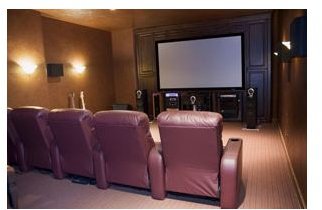Getting the Best Home Theater Acoustics
Home Theater Acoustics
With increasingly greater numbers of people setting up home theaters, information on how to improve the quality of your home theater acoustics is becoming more in demand. To improve the quality of your home theater acoustics, you will need to consider several aspects including:
· Size of the room
· Floor, ceiling and wall surface materials
· Lighting
· Speaker size, type, placement and other acoustics-related factors
· Number and position of seating arrangement
Briefly, let’s have a closer look at each of these aspects in more detail.
Size of the Room
The size of your room can affect your home theater acoustics to some degree. If the room is too compact in size, echoing could develop into a big problem. Too large a room could also negatively impact the acoustics as well. Although good results can be achieved with a range of room sizes, highly successful results have been achieved with home theaters in proportions from 18 to 20 feet in width, from 25 to 30 feet long and approximately 11 feet in height. This is before addition of home theater acoustic paneling intended to absorb or redirect sound in the room. This paneling and other types of room treatments can be up to six inches in thickness depending on requirements.
Floor, Ceiling and Wall Surface Materials
Sound is easily deflected from or bounced off of bare, hard surfaces. The surface materials used to coat or cover floor, ceiling and wall coverings greatly affect the type and quality of sound. Standing, or fixed frequency sound waves reflect or bounce off of home theater acoustic sound surfaces. Depending on the surface materials, sound waves can be distorted by any surfaces in a home theater environment causing thick, fuzzy-sounding speech, harsh, off-pitch sound effects which mar the listening aspects of a home theater experience. Soft wall, ceiling and floor surfaces such as cork, sponge, elastics or sound transparent cloth can be applied as required to absorb, reflect or scatter sound waves which can bounce back and forth on each other creating acoustic “holes” or “openings" in acoustic coverage. Plush carpeting, transparent to sound waves, offer one type of floor treatment to minimize sound wave reflection from stark, hard floors. Fabric curtains can provide an effective sound controlling wall treatment for many home theaters.
Lighting
Who of us has never experienced the annoyance and discomfort of unwanted glare and reflections from stray lighting in a room? Home theater lighting should be adjustable via a rheostat or multiple lighting panels along the front, sides or to the rear of the room. Controls for lighting can also have multiple locations in the home theater for ease of adjustment. Controls might be placed in a console located on or near home theater seating. A lighting control panel could be placed in a convenient location near seating on a wall or other specialized location for the convenience of viewers. Incandescent lighting gives an orange cast, while fluorescent lighting gives off a greenish cast which can alter color balance in home theater viewing. Too much lighting can cause glare and promotes eye strain. Too little light can also have a traumatic effect causing stress and eyestrain.
Speaker Size, Type, Placement and other Acoustics-related Factors
In a “perfect” home theater acoustics arrangement, the speakers re-create the original pure sound as captured in the studio where the production was recorded. The speech and sounds of the production are free of reflections, blurring and distortion. As in nature, sounds come to our ears from virtually all directions, in front, from the sides, diagonally and often, from behind us. Home theater acoustics attempt to provide a similar sound saturation experience by using speakers sized, located and adjusted to provide the richest, cleanest, most realistic listening scenario possible in the home theater environment. In the final steps of creating the best possible home theater acoustics, an arrangement employing at least four speakers can be shifted around to form a custom listening environment which minimizes the production of standing waves often formed by speakers incorrectly placed in tightly corners of a room. Be sure to use a sound equalizer to aid in attaining acoustic balance to your home theater. Read Home Theater Speaker Placement to learn more.
Number and Position of Seating Arrangement
The number of seats will be determined by the home theater room size and the quantity of people normally available for viewing productions. A generous range of features are currently available for seating. Massage vibrators, integral heating pads, variable recliner positions, adjustable head and foot rests, attachments for holding cups, food and accessories are all available at nominal prices. Upholstering materials can include leather, fabric and spill-resistant materials for those moments when excitement and beverages have a potentially unfortunate meeting. Chairs can be padded, swivel, rock and tilt to any angle needed for the comfort of the viewer. Home Theater Seating Tips and Ideas can offer up some helpful information.
Principles of Home Theater Acoustics
We’ve briefly considered some essential elements of home theater acoustics. By carefully considering and applying these principles to aid in minimizing difficulties with acoustics, anyone can optimize their home theater viewing experience, enjoying the best in sound and visual combinations for truly memorable presentations of 2D and 3D film offerings.
